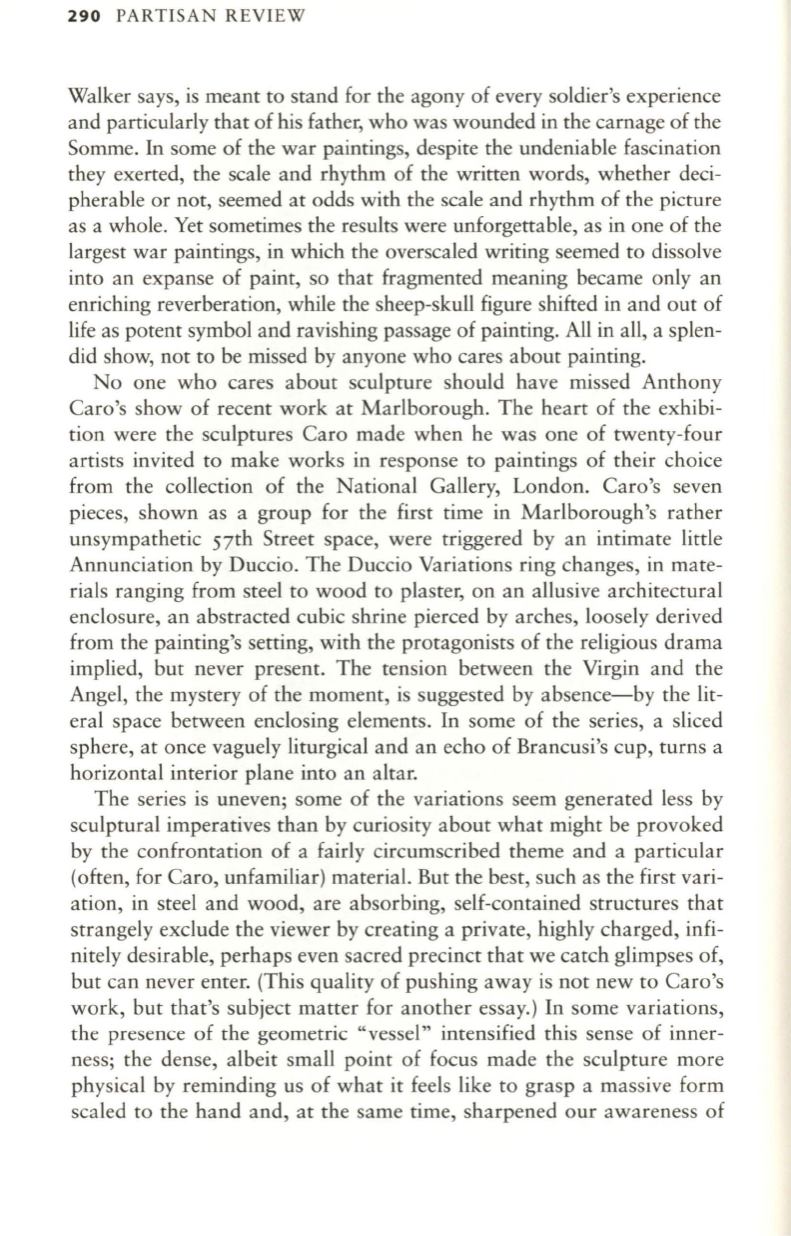
290
PARTISAN REVIEW
Walker says, is meant
to
stand for the agony of every soldier's experience
and particularly that of his father, who was wounded in the carnage of the
Somme.
In
some of the war paintings, despite the undeniable fascination
they exerted, the scale and rhythm of the written words, whether deci–
pherable or not, seemed at odds with the scale and rhythm of the picture
as a whole. Yet sometimes the results were unforgettable, as in one of the
largest war paintings, in which the overscaled writing seemed to dissolve
into an expanse of paint, so that fragmented meaning became only an
enriching reverberation, while the sheep-skull figure shifted in and out of
life as potent symbol and ravishing passage of painting. All in all, a splen–
did show, not to be missed by anyone who cares about painting.
No one who cares about sculpture should have missed Anthony
Caro's show of recent work at Marlborough. The heart of the exhibi–
tion were the sculptures Caro made when he was one of twenty-four
artists invited to make works in response to paintings of their choice
from the collection of the National Gallery, London. Caro's seven
pieces, shown as a group for the first time in Marlborough's rather
unsympathetic 57th Street space, were triggered by an intimate little
Annunciation by Duccio. The Duccio Variations ring changes, in mate–
rials ranging from steel to wood to plaster, on an allusive architectural
enclosure, an abstracted cubic shrine pierced by arches, loosely derived
from the painting's setting, with the protagonists of the religious drama
implied, but never present. The tension between the Virgin and the
Angel, the mystery of the moment, is suggested by absence-by the lit–
eral space between enclosing elements.
In
some of the series, a sliced
sphere, at once vaguely liturgical and an echo of Brancusi's cup, turns a
horizontal interior plane into an altar.
The series is uneven; some of the variations seem generated less by
sculptural imperatives than by curiosity about what might be provoked
by the confrontation of a fairly circumscribed theme and a particular
(often, for Caro, unfamiliar) material. But the best, such as the first vari–
ation, in steel and wood, are absorbing, self-contained structures that
strangely exclude the viewer by creating a private, highly charged, infi–
nitely desirable, perhaps even sacred precinct that we catch glimpses of,
but can never enter. (This quality of pushing away is not new
to
Caro's
work, but that's subject matter for another essay.)
In
some variations,
the presence of the geometric "vessel" intensified this sense of inner–
ness; the dense, albeit small point of focus made the sculpture more
physical by reminding us of what it feels like
to
grasp a massive form
scaled to the hand and, at the same time, sharpened our awareness of


